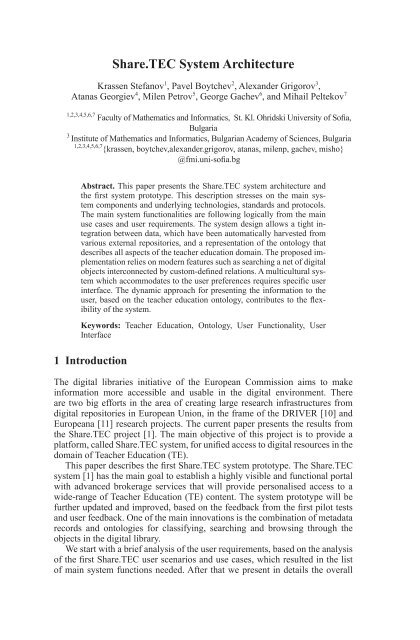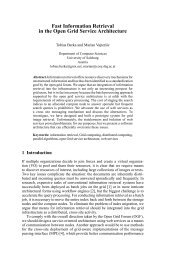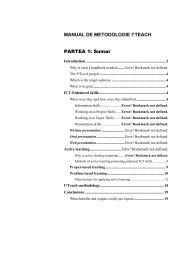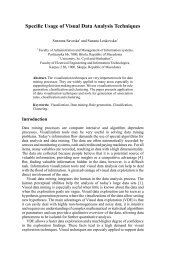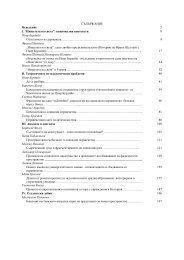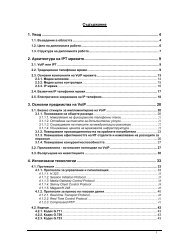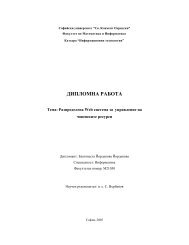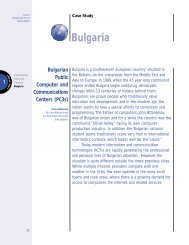Share.TEC System Architecture - Research at Sofia University
Share.TEC System Architecture - Research at Sofia University
Share.TEC System Architecture - Research at Sofia University
You also want an ePaper? Increase the reach of your titles
YUMPU automatically turns print PDFs into web optimized ePapers that Google loves.
<strong>Share</strong>.<strong>TEC</strong> <strong>System</strong> <strong>Architecture</strong>Krassen Stefanov 1 , Pavel Boytchev 2 , Alexander Grigorov 3 ,Atanas Georgiev 4 , Milen Petrov 5 , George Gachev 6 , and Mihail Peltekov 71,2,3,4,5,6,7 Faculty of M<strong>at</strong>hem<strong>at</strong>ics and Inform<strong>at</strong>ics, St. Kl. Ohridski <strong>University</strong> of <strong>Sofia</strong>,Bulgaria3Institute of M<strong>at</strong>hem<strong>at</strong>ics and Inform<strong>at</strong>ics, Bulgarian Academy of Sciences, Bulgaria1,2,3,4,5,6,7 {krassen, boytchev,alexander.grigorov, <strong>at</strong>anas, milenp, gachev, misho}@fmi.uni-sofia.bgAbstract. This paper presents the <strong>Share</strong>.<strong>TEC</strong> system architecture andthe first system prototype. This description stresses on the main systemcomponents and underlying technologies, standards and protocols.The main system functionalities are following logically from the mainuse cases and user requirements. The system design allows a tight integr<strong>at</strong>ionbetween d<strong>at</strong>a, which have been autom<strong>at</strong>ically harvested fromvarious external repositories, and a represent<strong>at</strong>ion of the ontology th<strong>at</strong>describes all aspects of the teacher educ<strong>at</strong>ion domain. The proposed implement<strong>at</strong>ionrelies on modern fe<strong>at</strong>ures such as searching a net of digitalobjects interconnected by custom-defined rel<strong>at</strong>ions. A multicultural systemwhich accommod<strong>at</strong>es to the user preferences requires specific userinterface. The dynamic approach for presenting the inform<strong>at</strong>ion to theuser, based on the teacher educ<strong>at</strong>ion ontology, contributes to the flexibilityof the system.Keywords: Teacher Educ<strong>at</strong>ion, Ontology, User Functionality, UserInterface1 IntroductionThe digital libraries initi<strong>at</strong>ive of the European Commission aims to makeinform<strong>at</strong>ion more accessible and usable in the digital environment. Thereare two big efforts in the area of cre<strong>at</strong>ing large research infrastructures fromdigital repositories in European Union, in the frame of the DRIVER [10] andEuropeana [11] research projects. The current paper presents the results fromthe <strong>Share</strong>.<strong>TEC</strong> project [1]. The main objective of this project is to provide apl<strong>at</strong>form, called <strong>Share</strong>.<strong>TEC</strong> system, for unified access to digital resources in thedomain of Teacher Educ<strong>at</strong>ion (TE).This paper describes the first <strong>Share</strong>.<strong>TEC</strong> system prototype. The <strong>Share</strong>.<strong>TEC</strong>system [1] has the main goal to establish a highly visible and functional portalwith advanced brokerage services th<strong>at</strong> will provide personalised access to awide-range of Teacher Educ<strong>at</strong>ion (TE) content. The system prototype will befurther upd<strong>at</strong>ed and improved, based on the feedback from the first pilot testsand user feedback. One of the main innov<strong>at</strong>ions is the combin<strong>at</strong>ion of metad<strong>at</strong>arecords and ontologies for classifying, searching and browsing through theobjects in the digital library.We start with a brief analysis of the user requirements, based on the analysisof the first <strong>Share</strong>.<strong>TEC</strong> user scenarios and use cases, which resulted in the listof main system functions needed. After th<strong>at</strong> we present in details the overall
<strong>Share</strong>.<strong>TEC</strong> <strong>System</strong> <strong>Architecture</strong> 93<strong>Share</strong>.<strong>TEC</strong> system architecture and describe all main components used for thesystem implement<strong>at</strong>ion. We describe also the main communic<strong>at</strong>ion protocols,used to integr<strong>at</strong>e all main components into one integr<strong>at</strong>ed system, as well as themain software services offered from each of the main system components.Finally, we present the main results from the first valid<strong>at</strong>ion session of the<strong>Share</strong>.<strong>TEC</strong> system prototype, and main directions for its future developmentand improvement.2 RequirementsThe <strong>Share</strong>.<strong>TEC</strong> system is based on the set of scenarios and use cases specifiedin <strong>Share</strong>.<strong>TEC</strong> project [1].On the base of these use cases the main system requirements were developed,which identify the main system functionalities.We can classify all main user functions, identified on the base of the analysisof the system requirements, into several groups:• Account management functions. These are functions rel<strong>at</strong>ed to cre<strong>at</strong>ingand removing user accounts, logging in and out of the system, andpassword reset. They are: register, unregister, log in, log out, passwordreset, profile change.• Profile management functions. These functions allow the user to modifyhis/her profile and customize the way <strong>Share</strong>.<strong>TEC</strong> presents inform<strong>at</strong>ion.They are: personal profile, custom front page, preferences, multilingualinterface.• Searching and navig<strong>at</strong>ion functions. These functions provide theability to browse, filter and search the d<strong>at</strong>a which is stored <strong>at</strong> <strong>Share</strong>.<strong>TEC</strong> repository. They are: browsing (navig<strong>at</strong>ion), searching, filteringand alerts.• Authoring functions. These functions allow the user to contribute tothe <strong>Share</strong>.<strong>TEC</strong> content by providing annot<strong>at</strong>ions, ranking and addingreferences. They are: annot<strong>at</strong>ion, ranking, enriching and addingreferences.An important issue about the user functionalities is th<strong>at</strong> they are dependenton the st<strong>at</strong>us of the user. Generally, there are two types of <strong>Share</strong>.<strong>TEC</strong> users– registered and non-registered (anonymous). Registered users have access tomore functions and they are recognized by the system as actors. Registeredusers could be either logged in or logged out. A logged out user th<strong>at</strong> uses thesystem is tre<strong>at</strong>ed as unregistered user.3 <strong>Share</strong>.<strong>TEC</strong> system prototype – a detailed descriptionThe first <strong>Share</strong>.<strong>TEC</strong> system prototype was developed following the generalarchitecture as depicted in Figure 1 (including the main system components aswell as the protocols used for their communic<strong>at</strong>ions).The main component in the first system prototype is the <strong>Share</strong>.<strong>TEC</strong>Repository, which was also named central repository or repository cache. Thecentral repository contains metad<strong>at</strong>a representing resources from the Teacher
94 K. Stefanov et al.Educ<strong>at</strong>ion (TE) domain. These metad<strong>at</strong>a are represented in the CommonMetad<strong>at</strong>a Model (CMM) form<strong>at</strong> [2] and are collected from various sources:partners’ local metad<strong>at</strong>a repositories and external repositories or additionalsources containing such metad<strong>at</strong>a.RICKPartnerRepositoriesExternalRepositoriesSPICMMValid<strong>at</strong>ionServiceCMM CMMMMFMMFCMMCMMSPIOAI-PMHHarvesterUser Modeling<strong>Share</strong>.<strong>TEC</strong>RepositoryInteraction WizardHTTPUserSearchingCentralPortalFig. 1. Main <strong>Share</strong>.<strong>TEC</strong> architecture.The central repository also contains the represent<strong>at</strong>ion of the TeacherEduc<strong>at</strong>ion Ontology (TEO) [3]. The ontology was initially developed using theProtégé editor and l<strong>at</strong>er on it was imported to the central repository. The detailsfor the represent<strong>at</strong>ion of CMM and TEO in the repository are given in [4].We choose to use Fedora Commons Repository system as a central repository(cache). The main reasons for choosing Fedora were explained in details in [1],following the similar analysis [5, 6].TEO will be stored in the central Fedora repository using the EnhancedContent Model, which enables support for OWL Lite. The OWL description
<strong>Share</strong>.<strong>TEC</strong> <strong>System</strong> <strong>Architecture</strong> 95of the TEO will be extracted from the Protégé tool, which was used for theimplement<strong>at</strong>ion of the ontology, and after th<strong>at</strong> imported to Fedora. Whenneeded, additional manual editing will complement the full implement<strong>at</strong>ion ofTEO and its fe<strong>at</strong>ures to Fedora.The other main component of the system prototype is the central portal.The central portal is the place where the user of the <strong>Share</strong>.<strong>TEC</strong> system cancommunic<strong>at</strong>e with all of its components and to specify wh<strong>at</strong> services she/heneeds from the system.The role of the user interface is multifold: to represent the main systemservices and components to the user in a n<strong>at</strong>ural way; to enable the user toexpress wh<strong>at</strong> she/he wants from the system; to formul<strong>at</strong>e the right set of queriesto the various components and services involved; to collect the results fromthese components and services, and to represent results in a n<strong>at</strong>ural way to theend user.The main set of services offered to the user is rel<strong>at</strong>ed to the realiz<strong>at</strong>ion ofdifferent types of searches of varying complexity to the central repository.The <strong>Share</strong>.<strong>TEC</strong> Web Portal allows the autom<strong>at</strong>ic personaliz<strong>at</strong>ion of portalinterface to m<strong>at</strong>ch user’s language, community role, and history. All queriescan be performed in the project partner’s n<strong>at</strong>ive language (Bulgarian, Dutch,English, Italian, Spanish, Swedish) and in reference to the user’s own contextby:• simple and advanced range of parameters for query filtering;• key parameter values autom<strong>at</strong>ically set in accordance with user profile(override available);• allowance for multiple values to be <strong>at</strong>tributed to each parameter.Autom<strong>at</strong>ic ranking of search results in accordance with user profilecharacteristics (weighting) will be also supported.All metad<strong>at</strong>a descriptions found allow previewing the correspondingresources. Comprehensive recommender hints will be offered, to which taggedindividual user favourites will be aggreg<strong>at</strong>ed.A specific form, based on the personalized user profile, will be used foradding user feedback, like r<strong>at</strong>ing and experiential annot<strong>at</strong>ion of resources.The third main component from the first system prototype is the Harvester.The harvesting process, as chosen for the implement<strong>at</strong>ion in the <strong>Share</strong>.<strong>TEC</strong>system prototype [7], includes the Harvester (program for importing metad<strong>at</strong>arecords taken from a number of digital repositories, into one central repository),metad<strong>at</strong>a valid<strong>at</strong>ion service (program ensuring th<strong>at</strong> all the harvested metad<strong>at</strong>arecords have the right d<strong>at</strong>a form<strong>at</strong>) and OAI-PMH target (the point where agiven digital repository is providing access to its metad<strong>at</strong>a records through theOAI-PMH protocol).The central repository is searching and retrieving all the sources of CMMmetad<strong>at</strong>a using the OAI-PMH Harvester – special computer program whichperiodically connects to all sources of metad<strong>at</strong>a, and using the OAI-PMH [8]protocol is collecting all new instances of metad<strong>at</strong>a from these sources, andwrites all these new metad<strong>at</strong>a into the central repository. The Harvester is alsoresponsible for the valid<strong>at</strong>ion of the metad<strong>at</strong>a through the valid<strong>at</strong>ion service– it checks whether all such metad<strong>at</strong>a records conform to the CMM form<strong>at</strong>,and inserts only the successfully valid<strong>at</strong>ed metad<strong>at</strong>a records to the centralrepository.
96 K. Stefanov et al.Other very important components for the first system prototype are theexisting external well-known digital repositories, containing relevant for thedomain of TE domain metad<strong>at</strong>a, as well as the local repositories established <strong>at</strong>each project partner site. They served as the initial d<strong>at</strong>abases from which thecentral <strong>Share</strong>.<strong>TEC</strong> repository was initially popul<strong>at</strong>ed with metad<strong>at</strong>a.To support the initial popul<strong>at</strong>ion of CMM metad<strong>at</strong>a records to the central<strong>Share</strong>.<strong>TEC</strong> repository from the local partner’s repositories by autom<strong>at</strong>edimporting of existing metad<strong>at</strong>a form<strong>at</strong>s (for example, providing autom<strong>at</strong>ictransl<strong>at</strong>ion of existing DC or LOM rel<strong>at</strong>ed metad<strong>at</strong>a form<strong>at</strong>s to CMM), a specificprogram called MMF (Metad<strong>at</strong>a Migr<strong>at</strong>ion Facility) was also provided. MMFis mainly playing the role of transl<strong>at</strong>ing from well-known metad<strong>at</strong>a form<strong>at</strong>s toCMM. Besides popul<strong>at</strong>ing metad<strong>at</strong>a records from partners’ repositories, MMFwill take all the metad<strong>at</strong>a records coming from the well-known TE externalrepositories, convert them to CMM, and feed them to the central repositorythrough the Harvester.In order to gener<strong>at</strong>e new CMM metad<strong>at</strong>a records <strong>at</strong> partners’ repositories,we provide a comprehensive support tool for the cre<strong>at</strong>ion of metad<strong>at</strong>a records(Resource Integr<strong>at</strong>ion Companion Kit – RICK). Initially, this component canextract some of the metad<strong>at</strong>a fields’ values autom<strong>at</strong>ically (such as file type,owner, d<strong>at</strong>e, keywords, etc). Next, this tool can offer a web form to the user forfilling all of the required and missing fields, as well as any other non-oblig<strong>at</strong>oryfield. In the end, RICK should cre<strong>at</strong>e new metad<strong>at</strong>a records in user’s localrepository, while an opportunity will be also offered to store the resource itselfeither in the local repository, or in some other place of choice (such as Youtube,Delicious, Flickr). For the first prototype, we will offer only interactive formsfilling-in (no autom<strong>at</strong>ic gener<strong>at</strong>ion), and we will store only metad<strong>at</strong>a records inthe local repository.The RICK tool gives support to individual users for “cre<strong>at</strong>ing resourcerecords according to the <strong>Share</strong>.<strong>TEC</strong> metad<strong>at</strong>a model”. Therefore, we envisionRICK as an interactive user request driven tool (not providing full autom<strong>at</strong>icmetad<strong>at</strong>a record cre<strong>at</strong>ion) th<strong>at</strong> employs the SPI publishing interface betweenRICK and partners’ CMM-compliant repositories.For the first system prototype we include preliminary versions of MMF andRICK.Below we present the description of the main <strong>Share</strong>.<strong>TEC</strong> software services,grouped by the corresponding <strong>Share</strong>.<strong>TEC</strong> system component, offering them:• Harvesting services management (accessible by system administr<strong>at</strong>ors)• Adding new metad<strong>at</strong>a records manually to chosen local repository viaSPI• Cre<strong>at</strong>ing interactively metad<strong>at</strong>a records to be stored in chosen localrepository using the RICK tool• Favourite service (allowing to organize digital content objects asfavourites via tags from a personal user, like in del.icio.org)• Metad<strong>at</strong>a valid<strong>at</strong>ion service (before adding metad<strong>at</strong>a records to thecentral repository, each one should be valid<strong>at</strong>ed)• Searching service (search the central repository for resources based ondefined queries)• Browsing service (browsing the central repository objects andrel<strong>at</strong>ions)
<strong>Share</strong>.<strong>TEC</strong> <strong>System</strong> <strong>Architecture</strong> 97• Queries description service• Ranking resource service (manually or autom<strong>at</strong>ically, based on users’profile and context)• Presenting the search results taking into account user model, useractivities (ranking etc.), history and other user interface personaliz<strong>at</strong>iondetails• Brokerage service (ensured by the User Model, built via tracking theindividual user’s actions and storing them for further analysis, providingthe basis for weighting search results and tuning recommend<strong>at</strong>ions,personalising them further)• Preview of metad<strong>at</strong>a resources and (if possible) of the resource assetitself (if public)• User authentic<strong>at</strong>ion service• User authoriz<strong>at</strong>ion service• User management service• Backup and recovery (<strong>System</strong> administr<strong>at</strong>ion service)• St<strong>at</strong>istics (<strong>System</strong> administr<strong>at</strong>ion service)• Logging (<strong>System</strong> administr<strong>at</strong>ion service)• Community particip<strong>at</strong>ion Service4 Wizard and user interfaceThis section describes the implement<strong>at</strong>ion of the user interface through the<strong>Share</strong>.<strong>TEC</strong> portal component. The <strong>Share</strong>.<strong>TEC</strong> portal implements these enduserfunctions and functionalities through the Drupal CMS portal software[9]. It allows the autom<strong>at</strong>ic personaliz<strong>at</strong>ion of portal interface to m<strong>at</strong>ch user’slanguage, community role, and history. All queries can be performed in theuser’s n<strong>at</strong>ive language and in reference to the user’s own context by:• simple and advanced range of parameters for query filtering;• key parameter values autom<strong>at</strong>ically set in accordance with user profile(override available);• allowance for multiple values to be <strong>at</strong>tributed to each parameter.The <strong>Share</strong>.<strong>TEC</strong> portal implements the user interface to all services available.Some of these services are loc<strong>at</strong>ed and offered by Fedora repository (centralcache), others will be developed during the project and will be stored in theportal d<strong>at</strong>abase.The main principles of the user interface design for the <strong>Share</strong>.<strong>TEC</strong> systemfollow the main requirements st<strong>at</strong>ed in the project proposal:• <strong>Share</strong>.<strong>TEC</strong> digital environment is tangible to users and easy tonavig<strong>at</strong>e• It is based on interactive visualiz<strong>at</strong>ions, adapted to user profilesand current user objectives, and open up for new opportunities forcollabor<strong>at</strong>ion and community building• The system provides a visual metad<strong>at</strong>a search engine• An adaptive wizard based on the ontology model and individual userhistory enhances the interaction with the system and increases the
98 K. Stefanov et al.•effectiveness of user’s queries by making their tacit, contextualizedknowledge explicit.The user interface is fully multilingual.For the implement<strong>at</strong>ion of the user interface we use various fields, lists,hierarchies and other relevant d<strong>at</strong>a components from CMM and TEO. All therel<strong>at</strong>ions between the user interface components and the relevant CMM andTEO components were described in details in [1].The multi-cultural aspects are represented in the CMM and TEO modelsas specific multi-cultural extensions, and are covered using the multilingualaspects of the user interface. These fe<strong>at</strong>ures are still in development phase andwill be further tested, evalu<strong>at</strong>ed and enhanced.5 ConclusionIn this paper we described the development of the first <strong>Share</strong>.<strong>TEC</strong> systemprototype. The main URL of the system portal providing the main user interfaceto the system is: http://sharetec.it.fmi.uni-sofia.bg/For the first prototype we succeed to harvest metad<strong>at</strong>a from the followingrepositories: CENEC, OUNL, Stockholm <strong>University</strong>, SU-NIS, TCD, UVA,Teacher TV.As a result, the main system repository contains more than 200 metad<strong>at</strong>arecords, describing various resources from the Teacher Educ<strong>at</strong>ion domain.For the next system release and for the first system pilot, we expect to havealso all the metad<strong>at</strong>a from all the partners repositories.During the second <strong>Share</strong>.<strong>TEC</strong> workshop held in Dublin, we performedextended testing and valid<strong>at</strong>ion of the system prototype, in order to receivethe first significant feedback from the users, and to plan all the needed systemchanges and enhancements for the first pilot experiment. The valid<strong>at</strong>ion aimedto measure the reliability, availability and usability of the system, as well as totest it again several use cases designed in advance using specific think allowedprotocol techniques. All details from the valid<strong>at</strong>ion will be described in thespecific project deliverable. The main preliminary results from the valid<strong>at</strong>ionshow, th<strong>at</strong> the system prototype is allowing the users to perform all the plannedand expected tasks with the system. Generally, the system is functional,available, reliable and easy to be used. Some specific user recommend<strong>at</strong>ionswere recorded and will be taken into account for the development of the firstsystem pilot version.Acknowledgments. This work is supported by EC project <strong>Share</strong>.<strong>TEC</strong> - SHAringDigital REsources in the Teaching Educ<strong>at</strong>ion Community, eContentplusprogramme (ECP 2007 EDU 427015); http://www.sharetecproject.eu/.References1.2.<strong>Share</strong>.<strong>TEC</strong> Project Deliverable D5.4 Development of the system prototype, http://www.share-tec.eu/<strong>Share</strong>.<strong>TEC</strong> Project Deliverable D2.2 Common Metad<strong>at</strong>a Model (CMM): version 1,http://www.share-tec.eu/content/1/c6/04/41/02/D2_2_Common_Metad<strong>at</strong>a_Model.pdf
<strong>Share</strong>.<strong>TEC</strong> <strong>System</strong> <strong>Architecture</strong> 993.4.5.6.7.8.9.10.11.Teacher Educ<strong>at</strong>ion Ontology (TEO): version 1, http://www.share-tec.eu/content/1/c6/04/41/02/D2_1_TEO_v1.pdf<strong>Share</strong>.<strong>TEC</strong> Project Deliverable D2.3 Ontology and Metad<strong>at</strong>a Models: release versions,http://www.share-tec.eu/Repository Software Survey, March 2009 http://www.rsp.ac.uk/software/surveyresultsTechnical Evalu<strong>at</strong>ion of <strong>Research</strong> Repositories, https://eduforge.org/docman/view.php/131/1062/Repository Evalu<strong>at</strong>ion Document.pdfHarvesting LOM, http://ariadne.cs.kuleuven.be/lomi/index.php/Harvesting_LOM,Accessed: March 10, 2009Open Archives Initi<strong>at</strong>ive - Protocol for Metad<strong>at</strong>a Harvesting, http://www.openarchives.org/pmh/Drupal, http://drupal.org/M. Feijen, W. Horstmann, P. Manghi, M. Robinson and R. Russell, DRIVER:Building the Network for Accessing Digital Repositories across Europe. AriadneIssue 53 October 2007.Europeana v1.0, Description of Work, http://version1.europeana.eu/c/document_library/get_file?uuid=cf720627-d351-48dc-9ef0-b10b326591d1&groupId=10602


